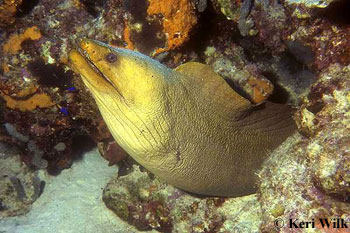
Gymnothorax funebris
One of the largest of the morays, the green moray is often found at 6 feet long but can reach 8 feet and 65 pounds. Although it is actually dark grey-brown, it is covered in a thick yellow mucus, giving it its green coloring and protecting it from parasites and disease. Like most morays, it is an elongated and specialized fish that has only an extended dorsal fin and a small caudal (tail) fin. They forage at night, and spend their days in rocky crevices, which makes them a threat to unwary divers. Their bite can be painful, and sometimes life-threatening.
Order: Anguilliformes
Family: Muraenidae
Genus: Gymnothorax
Species: funebris
Common Names
Common names in English-speaking countries are green moray, black moray, green cong, green conger, green congo, green eel, and olive-green moray eel. Other common names include culebra berde (Papiamento), culebra murena (Spanish), groene murene (Dutch), kolebra berde (Papiamento), moreia-verde (Portuguese), morena (Spanish), morena congrio (Spanish), morena verde (Spanish), muräna (Swedish), murena (Spanish), murena berde (Spanish), and vihermureena (Finnish).
Importance to Humans
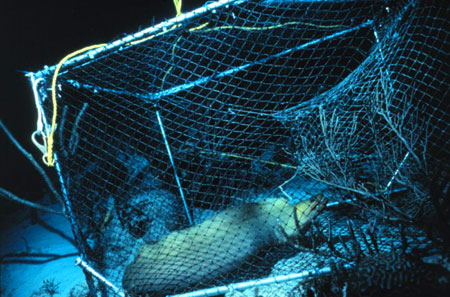
Green morays are of interest to divers, private aquarists with the facilities to maintain them, and with visitors to large commercial aquaria. The aesthetic appeal of the green moray has therefore generated a great deal of economic interest. Within their native range they are eaten by some indigenous peoples but the risk of contracting ciguatera poisoning from this species is considered great.
Danger to Humans
Large green morays are potentially dangerous fish. Green morays are often observed with their heads protruding from a crevice or hole and such individuals do not often flee from approaching divers and may even allow contact. It is during such contact, particularly in those situations in which a diver is feeding a moray that bites are most likely to occur. Additionally, unwary divers who indiscriminately probe reef holes and crevices with their hands are also at risk to suffer a bite from this species or other reef organisms. There are reports of unprovoked attacks attributed to the green moray but such incidents are thought to be exceedingly unusual. Although few encounters between people and morays result in injury, extreme caution should be exercised in any interaction with this species or other large morays. A bite from a large moray has the potential to be severe and potentially life-threatening.
Ciguatera poisoning in humans as a direct result of the consumption of large green morays is well documented. Ciguatera poisoning is caused by dinoflagellates (microalgae) found on dead corals or macroalgae. By feeding on these corals and macroalgae, herbivorous fishes accumulate a toxin generated by these dinoflagellates. Largely a phenomenon of tropical marine environments, ciguitoxin accumulates still further in the large predatory reef species that feed on herbivorous fishes. If accumulated levels of the toxin are great enough they can cause poisoning in humans whom consume the flesh of ciguitoxic fishes, be they herbivore or carnivore. Poisoned people report having gastrointestinal problems for up to several days, and a general weakness in their arms and legs. Many other unpleasant symptoms of ciguatera are well documented. Although it is very rare to be afflicted with ciguatera poisoning this is due in large part to our knowledge of what species are likely to be toxic and the discretion of those who enjoy seafood. Eating the flesh of a green moray is a risky proposition with very little reward in the face of considerable risk.
Conservation
This species is not currently listed by the World Conservation Union (IUCN). The IUCN is a global union of states, governmental agencies, and non-governmental organizations in a partnership that assesses the conservation status of species.
> Check the status of the green moray at the IUCN website.
Geographical Distribution
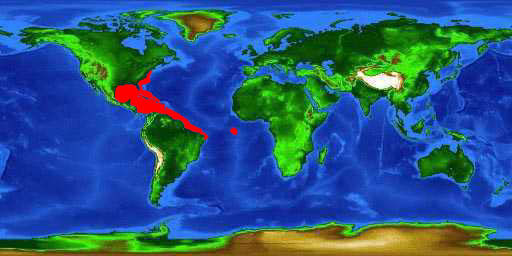
The green moray occurs in the western Atlantic Ocean from New Jersey to Bermuda and the northern Gulf of Mexico, south to Brazil, including Ascensión Island. Common throughout the warm waters of the Bahamas, Caribbean Sea, and Florida Keys, the species has been recorded at least once as far north as Nova Scotia, Canada. The latter record likely representing a stray carried north by the Gulfstream.
Habitat
Associated with rocky shorelines, coral reefs, and mangroves, the green moray is a benthic, solitary fish. The species is also known from tidal creeks, harbors, areas over sand and mud bottoms, and among seagrass beds. This moray resides in waters shallower than 100 feet (30m). It hides during the day in rocky crevices, extending its head from the opening, and forages at night.
Biology
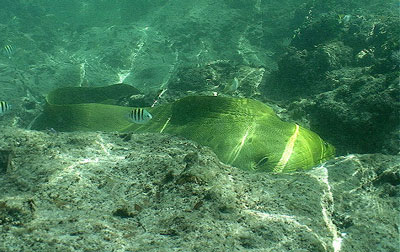
Distinctive Features
The elongate body is laterally compressed or “flattened” and this fish possesses a muscular appearance. The scaleless, thick skin is covered by a layer of yellowish mucus that protects the animal from parasites and diseases. It is this mucus that lends the moray the green tint for which it is named. The green moray lacks pelvic and pectoral fins, the former true of all eels, the latter true of all morays. The dorsal and anal fins are long and are continuous with the short caudal fin. The incurrent nostrils are conspicuous tube-like structures, while the excurrent pair take the form of simple openings. The mouth is constantly opening and closing, mechanically pumping the water required for respiration. This water passes over the small, spherical gills, eventually exiting via the gill slits. The gills and gill slits are very small, as the oxygen demands of this rather sedentary fish are not as great as more active species.
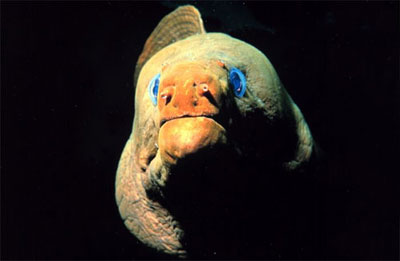
Coloration
A drab and dark colored animal in preservation, it is the yellow tint of the mucus that covers the body of this eel, in combination with the dark ground color, which produces the green appearance for which the species is commonly named. It is from the dark ground color however, that the species name “funebris” (literally “funereal”) is derived. Dark or light green or even somewhat brown, body color is uniform from head to tail. There are no markings on the body or fins. Juveniles are uniformly dark and lack the presence of a white chin, a character noted for the young of at least two other species of the genus Gymnothorax as well as other morays.
Dentition
The teeth of the green moray are large, smooth edged and easy to see when the jaws are agape. Although the number of tooth rows appears to be a condition correlated with age, in general the following can be said to be true of adults. Towards the front of the upper jaw can be found two rows of teeth although along the rear of the jaw there is only one. Teeth on the roof of the mouth (known as vomerine teeth) of adults are also arranged in two rows. The lower jaw has a single row of teeth.
Size, Age, and Growth
The green moray is one of the largest morays. Maximum reported size for the species is 8ft (2.5m) and 65 pounds (29 kg). Average maximum size is likely closer to 6ft (1.8m) and 30 pounds (13.3 kg).
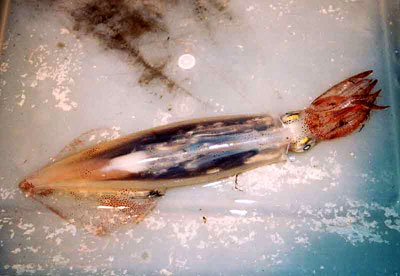
Food Habits
The green moray is nocturnal predator of fishes, crabs, cephalopods and shrimps that relies largely on its sense of smell to locate prey. Green morays are adept at working their way in and out of the many tight crevices and holes of coral reefs where fishes and other organisms hide. Green morays most often hunt in this manner at night.
Reproduction
Moray eels, like all true eels are oviparous. Although little is known regarding green moray spawning, fecundity and early development of the leptocephali, one published source records numerous ripe eggs measuring 1mm in diameter from a 1.1 meter female. In contrast to this single record other sources indicate a much larger size for the eggs of other morays, on the order of 3-4mm in diameter.
True-eels (Anguilliformes) along with the closely allied tarpon (Megalopidae), bonefish (Albulidae), and ladyfish (Elopidae) produce larvae known as leptocephali. These transparent, ribbon-like larvae drift amongst the plankton as they develop. Interestingly, muraenid leptocephali possess pectoral fins, a condition wholly different from that of the adults. It is during the transformation from leptocephalus to juvenile that the pectoral fins are resorbed.
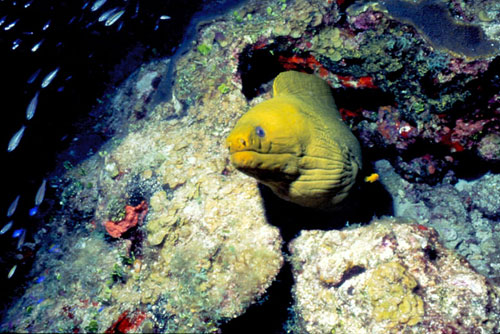
Although the leptocephalus larvae of the green moray is undescribed, leptocephali of the various species of moray in general are distinguishable by patterns of pigment, the number of trunk muscles (known as myomeres), and the position of the dorsal fin and the anus.Predators
Little is known regarding the predators of the green moray. Large individuals likely have few natural predators.
Parasites
Specific parasites associated with Gymnothorax funebris are not well studied if at all. However, this moray has been observed to visit wrasse-cleaning stations and submit to the activities of certain cleaner shrimps.
Taxonomy
Camillo Ranzani, director of the Museum of Natural History of Bologna, Italy from 1803 to 1841, first described the green moray in 1840 as Gymnothorax funebris. Later that year he also referred to the species as Lycodontis funebris. Owing to the principle of priority used in the naming of organisms, G. funebris is the accepted scientific name currently in use for the green moray. Other synonyms include, Muraena lineopinnis Richardson 1848,Thyrsoidea aterrima Kaup 1960, Muraena infernalis Poey 1861, and Taeniophis westphali Kaup 1860. The currently valid genus name Gymnothorax is translated from the Greek “gymnos”, “thorax”, and “-akos” as naked breast. The species name funebris is tranlated from Latin as having to do with burial.
Prepared by: Cathy Bester and Robert H. Robins